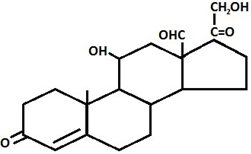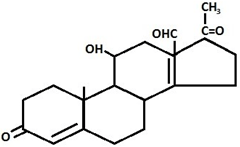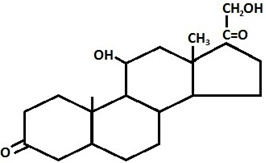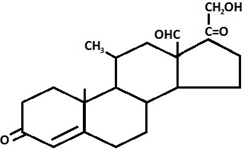This set of Molecular Endocrinology Multiple Choice Questions & Answers (MCQs) focuses on “Mineralo-corticoids”.
1. Which cells produce and secrete the chief mineralocorticoid hormone, aldosterone?
a) Zona glomerulosa of the adrenal cortex
b) Acinar cells
c) Follicular cells
d) Zona glomerulosa of the medulla
View Answer
Explanation: Zona glomerulosa cells of the adrenal cortex secrete aldosterone which is a mineralocorticoid hormone. Aldosterone has major roles to play in sodium retention, water retention, potassium elimination etc. Aldosterone is also known as adrenocorticotropic hormones.
2. Which among the following hormones can almost resemble aldosterone in its activity?
a) Corticosterone
b) 11-deoxycorticosterone (DOC)
c) 11-deoxycortisol
d) Cortisol
View Answer
Explanation: 11-Deoxycorticosterone, also known as 21-hydroxyprogesterone, or simply deoxycorticosterone, is an adrenal gland-produced steroid hormone that has mineralocorticoid activity and serves as a precursor to aldosterone. It has nearly the same effects as aldosterone, but only 1/30th of the potency of aldosterone.
3. Which steroid synthesizing enzyme is absent in zona glomerulosa cells of the adrenal cortex?
a) 18-hydroxylase
b) 11-β-hydroxylase
c) 17-α-hydroxylase
d) 21-hydroxylase
View Answer
Explanation: In zona glomerulosa, the enzyme 17-alpha-hydroxylase which has a role in the synthesis of steroid hormones is absent. Whereas 18-hydroxylase and 11-β-hydroxylase are only present in the zona glomerulosa cells of the adrenal cortex.
4. Mineralocorticoids can be synthesized in Zona glomerulosa cells only.
a) True
b) False
View Answer
Explanation: Mineralocorticoids can be synthesized in Zona glomerulosa cells only. The other two layers of the adrenal cortex cannot synthesize this hormone. The enzymes 18-hydroxylase and 18 hydroxysteroids dehydrogenase, which are lacking in other layers, are available only in zona glomerulosa cells.
5. Aldosterone occurs in the form of both ‘aldehyde’ and ‘hemiacetal.’
a) True
b) False
View Answer
Explanation: Aldosterone is present in the form of both ‘aldehyde’ and ‘hemiacetal.’ The hormone is believed to exist in solution in the hemiacetal form. Aldosterone spontaneously converts to the active, hemiacetal form. Aldosterone spontaneously converts to the active, hemiacetal form.
6. During the synthesis of mineralocorticoids, the progesterone formed from cholesterol is converted to 11-deoxy-corticosterone (DOC) by which enzyme?
a) 18-hydroxylase
b) 11-β-hydroxylase
c) 17-α-hydroxylase
d) 21-hydroxylase
View Answer
Explanation: There is a conversion of cholesterol to pregnenolone in the first step of the synthesis of mineralocorticoids. Afterward, Pregnenolone is converted to progesterone. Progesterone is then hydroxylated immediately by the 21-hydroxylase enzyme and forms 11-deoxy-corticosterone.
7. Which enzyme converts 18-OH-corticosterone to aldosterone in the final step of mineralocorticoid synthesis?
a) 18-hydroxylase
b) 11-β-hydroxylase
c) 18-hydroxy steroid dehydrogenase
d) 21-hydroxylase
View Answer
Explanation: In the final step, corticosterone is converted to 18-OH-corticosterone via the enzyme 18-hydroxylase. This is then acted upon to form aldosterone by a dehydrogenase, 18-hydroxy steroid dehydrogenase.
8. Where does the final step of mineralocorticoid synthesis takes place?
a) Cytoplasm
b) Nucleus
c) Endoplasmic reticulum
d) Mitochondria
View Answer
Explanation: Mineralocorticoids are finally processed in the mitochondria. The initial synthesis of mineralocorticoids take place in the endoplasmic reticulum. They are produced by the zona glomerulosa cells of adrenal cortex. They have roles to play in the water retention and electrolyte balance in the body.
9. Which among the following is the correct structure of aldosterone?
a)

b)

c)

d)

View Answer
Explanation: Aldosterone structurally has an-OH group at C11 and an aldehyde (-CHO) group at C18. 18-hydroxy steroid dehydrogenase oxidizes the 18-CH2OH group of 18-OH-corticosterone to an aldehyde (–CHO) group.
10. Which enzyme converts pregnenolone to progesterone in the first step of the synthesis of mineralocorticoids?
a) 18-hydroxylase
b) 3-β-OH-steroid dehydrogenase and Δ 4,5-isomerase
c) 18-hydroxy steroid dehydrogenase
d) 21-hydroxylase
View Answer
Explanation: Cholesterol is converted to pregnenolone in the first step of mineralocorticoid synthesis. In smooth ER, pregnenolone is then converted into progesterone catalyzed by the enzymes 3-β-OH-steroid dehydrogenase and Δ 4,5-isomerase.
Sanfoundry Global Education & Learning Series – Molecular Endocrinology.
To practice all areas of Molecular Endocrinology, here is complete set of 1000+ Multiple Choice Questions and Answers.
If you find a mistake in question / option / answer, kindly take a screenshot and email to [email protected]
